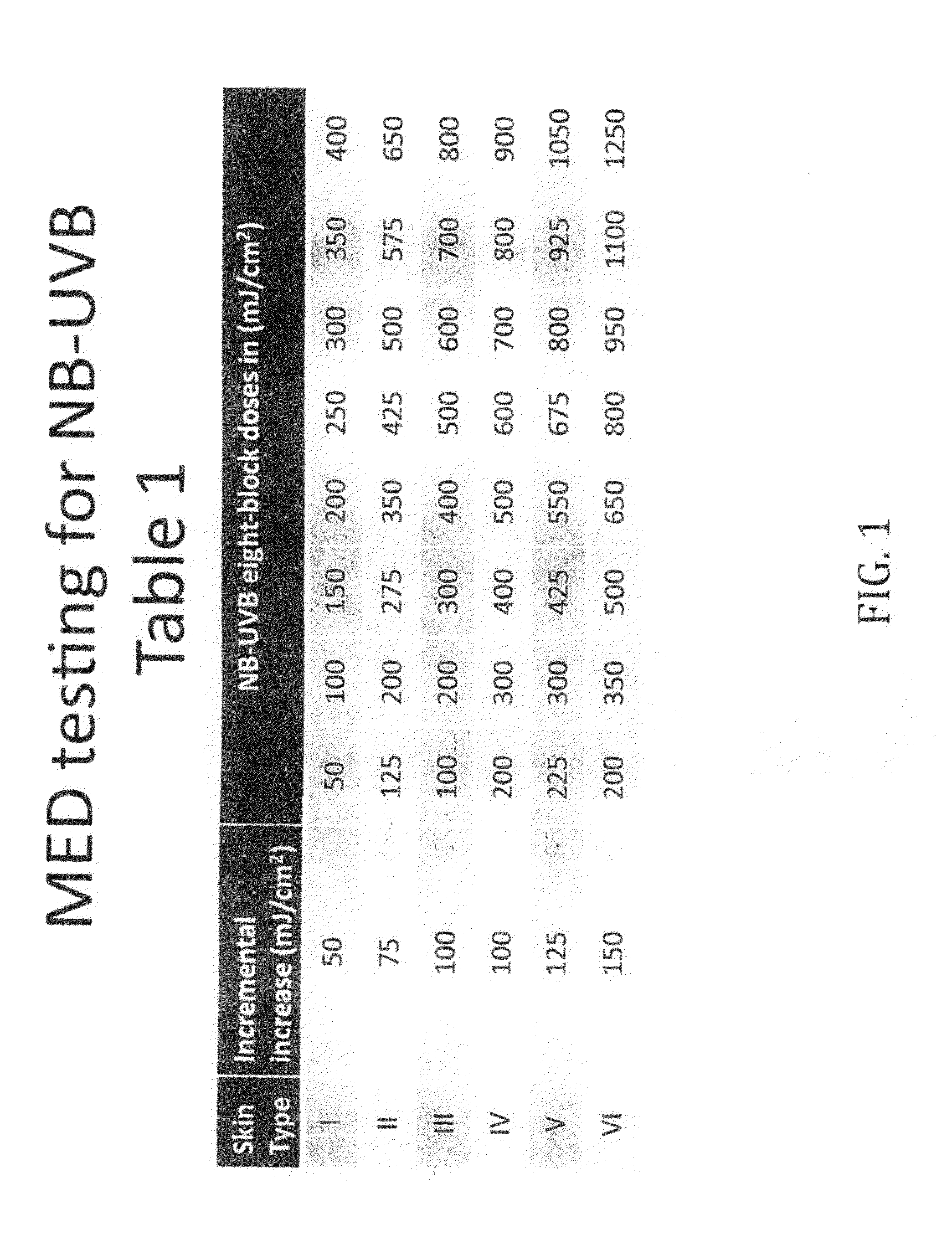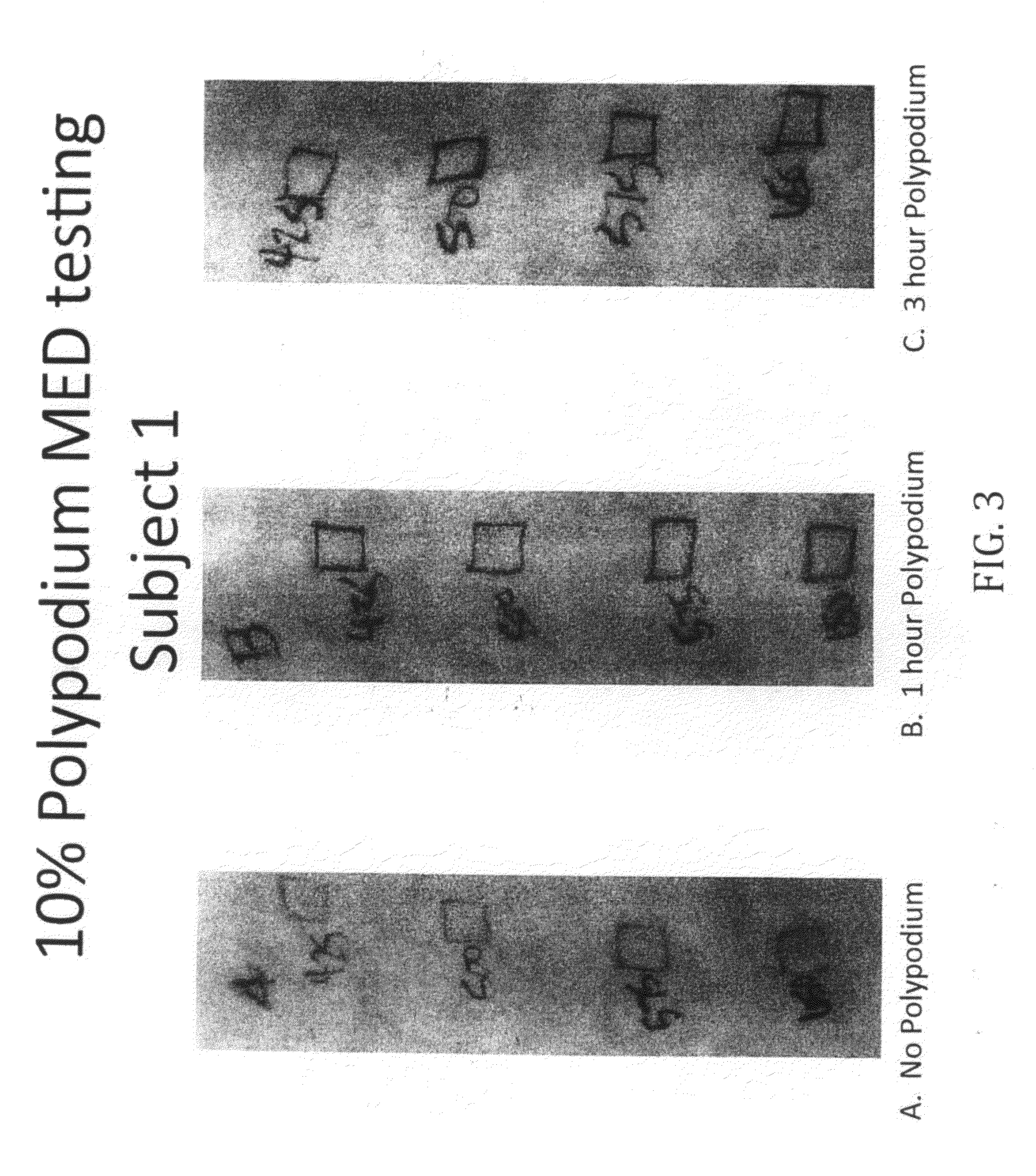Topical delivery and administration system for stabilized protection agent, compositions and methods of making same
- Summary
- Abstract
- Description
- Claims
- Application Information
AI Technical Summary
Benefits of technology
Problems solved by technology
Method used
Image
Examples
example 1
Preparations of Protective Agent Compositions
[0092]Polypodium extracts was reconstituted and diluted with solution.
[0093]In a round bottom flask of 50 ml. capacity, 10 mg of soluble collagen and 10 mg of elastin were combined. The mixture was solubilized in 10 ml— of sterile saline solution (0.9%) with continuous stirring. In a separate 50 ml— round bottom flask, 5 mg of sphingosine and 5 mg cerebroside were combined. This mixture was dissolved in pure ethanol. The alcohol was completely removed by rotary vacuum evaporation to obtain a uniform coating of the sphingosine and cerebroside on the flask wall. To this flask 400 units of Polypodium solution in 6 ml of diluting liquid was added. The flask was swirled and then stirred continuously for 5 minutes at room temperature to uniformly coat the Polypodium with the sphingosine and cerebroside micelle coating and suspend it in the solution. This coated, suspended and preserved micellar-like solution was then added to the flask containi...
example 2
Polypodium Cream Formulation
[0094]The stabilized Polypodium and carotenoid composition was formulated into a cream / lotion for topical administration as outlined below.
[0095]Total Volume of the cream / lotion (400 ml_)
Phase A:
De-ionized Water 74.7% Tetra Sodium EDTA 0.5-0.7% Methyl Paraben 0.2% Propylene
Glycol 3.0%-4.0% Glycerin 3.0%-4.0%
Phase B:
Cetyl Alcohol (Ado 1 52 NE) 2.0%
Cetearyl Alcohol 2.0%
Glyceryl Stearate 2.0%
PEG-100 Stearate 1-2%
Stearic Acid (Emersol 132) 4.5%
Sorbitan Palmitate 0.5-0.7%
Polysorbate-85 1.0%
Polysorbate 60 0.5-1%
Lanolin Alcohol (Ritachol) 1.0%
HoHoba Oil 0.5-1%
Lanolin 1-2%
Tocopheryl Acetate 0.5-1%
Dimethicone 200 0.7-1.0%
BHA 0.1%
Propylparaben 0.1%
Diazolidinyl UREA 0.2%
Phase C:
[0096]Fragrance (lilac, jasmine) as needed
CoQ-10 0.5%
Retinyl A 0.03-0.05%
[0097]Hyaluronic Acid (pure) 1.0-1.5%
Talcum Powder (TiO2) 1.0-1.5%
[0098]Phase D: d-limonene 0.7%
Allantoin 0.5%
Fulvic Acid 0.5%
[0099]Quillaja saponaria (QTS) 0.3%
Acanthophyllum squaimsom (ATS) ...
example 3
Clinical Studies In Human Subjects and Use of Composition
10% Topical Polypodium Test Protocol
[0102]1. Use an 8-square photo-opaque cutout template with a cutout area of 1 cm2. The cutouts will receive increasing increments of NB-UVB light (Dermalight-80, 311 nm UVB).
2. Apply a thin layer of topical polypodium to areas B and C on the midline and left lower back / left flank. Allow the polypodium to dry. Third subject had Vehicle to C.
3. Secure the template to area A (untreated area). Expose all cutouts for the first light dose. Then shield each cutout when it has received its target light dose. For example, skin type II will start with all cutouts exposed to 125 mJ / cm2 NB-UVB light. Then cutout #1 of the template is shielded because it has received its target of 125 mJ / cm2. The remaining cutouts are given the incremental increase of an additional 75 mJ / cm2. Then cutout #2 is shielded after it received a cumulative dose of 200 mJ / cm2. See table 1 for incremental increase based on Fitzpa...
PUM
| Property | Measurement | Unit |
|---|---|---|
| Fraction | aaaaa | aaaaa |
| Percent by mass | aaaaa | aaaaa |
| Percent by mass | aaaaa | aaaaa |
Abstract
Description
Claims
Application Information
 Login to View More
Login to View More - R&D
- Intellectual Property
- Life Sciences
- Materials
- Tech Scout
- Unparalleled Data Quality
- Higher Quality Content
- 60% Fewer Hallucinations
Browse by: Latest US Patents, China's latest patents, Technical Efficacy Thesaurus, Application Domain, Technology Topic, Popular Technical Reports.
© 2025 PatSnap. All rights reserved.Legal|Privacy policy|Modern Slavery Act Transparency Statement|Sitemap|About US| Contact US: help@patsnap.com



